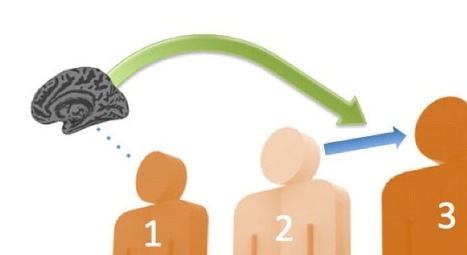Robin Good: In analyzing what is going on in the brain when a potentially viral idea is intercepted, Matthew Lieberman (who designed the study with Emily Falk at UCLA) discovered something that confirms how important it is that an effective curator be "in tune" with his own audience.
Great curation is not just about "spinning" the newest and coolest, but to precisely cater to the specific audience interests, expectations and preferences.
Interesting, fascinating story. Truthful. Insightful. 8/10
When President Obama considers how to mobilize opinion and persuade Americans to support his agenda, we can be sure he'll want to tap the power of changing minds by understanding what makes ideas go viral. In building support for tough, difficult issues such as deficit reduction and tax policy, the Obama team will want to know more about how buzz works in the brain.
At the Neuroleadership Summit 2012 held in mid-October in New York City, Art Kleiner, editor-in-chief of Strategy+Business magazine, joined me as we presented research casting new light on conventional thinking many of us have about buzz. Significantly, we're finding out that what makes ideas contagious has more to do with how we think about ideas than what we want to achieve with them. The "virality" of ideas is driven by people liking and passing on information specifically because we think others will enjoy or appreciate it.
Buzz is extraordinarily important because as social beings humans crave communication, and buzz spreads ideas like wildfire. In science, we like to use the word meme, a concept given to us by evolutionary biologist Richard Dawkins. Like genes, ideas must be replicated and passed on — or they die. When ideas become memes, they have the power to change people's minds, in fact to change our culture (and certainly a workplace). Consider how we think about the phrase "47 percent" now and a few months ago.
Memes are ideas, and ideas aren't ideas without people. So what have we discovered in the brain about what happens when an idea spreads out? At UCLA, Emily Falk and I devised a study to explore what is going on in the brain when we first encounter an idea that is destined to spread successfully. Here's how it worked. We came up with 20 ideas for new TV shows: these were our concepts, written so they couldn't be confused with any actual programming. We showed the TV show ideas to "subject one", while doing a brain scan. Then subject one essentially told another experiment participant we called "subject two" about the shows he wanted to recommend from the initial batch. Subject two never saw the original idea, only what subject one told him. After hearing subject one talk about the ideas, we then asked subject two which ideas he was excited about passing onto "subject three":
What we were interested in is what happens in the brain of subject one when they first see an idea that they will not only share with subject two, but do so in such a way that subject two will want to share it with subject three. Is there a signature of an idea that is destined to spread successfully in that first moment? We would not have been surprised to find activity in the classical parts of the brain associated with memory and deep encoding — regions activated when we try to hold onto critical information. After all, if you're excited enough about something to share it, wouldn't you make a point of committing it to memory? In fact, those parts of the brain did not stand out in our study; instead we found strong activity in the brain's mentalizing system, a network of brain regions central to thinking about other people's goals, feelings, and interests:
Full article: http://blogs.hbr.org/cs/2012/11/think_like_an_information_dj.html
Via Robin Good, Alejandro Tortolini, Manuel Gross, MyKLogica



 Your new post is loading...
Your new post is loading...








Useful curation perspective.